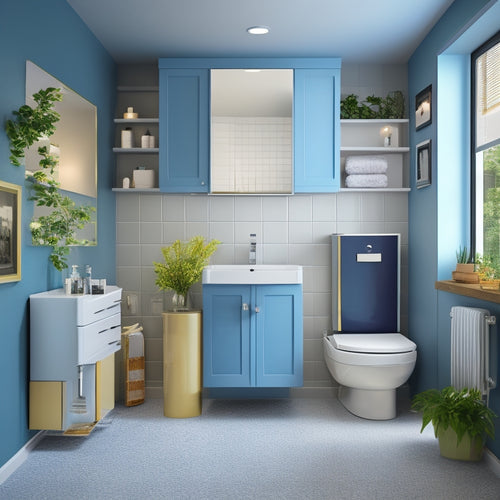
Bathroom Marble Top Installation for Beginners
Share
When installing a marble top in your bathroom, you'll want to begin by preparing the space, clearing it of furniture and fixtures, and evaluating the layout for plumbing and electrical outlets. Next, take precise measurements, using a tape measure and diagram, to guarantee accurate cutting with the right tools. Choose the suitable adhesive and sealant for a strong bond, and follow manufacturer instructions for application and curing. With these steps complete, you're ready to install your marble top, but remember, attention to detail is key, and a little patience now will save you from costly mistakes and future headaches - and there's still more to perfect for a flawless finish.
Key Takeaways
- Accurate measurements are crucial for successful installation, so employ the principle "measure twice, cut once" to avoid mistakes.
- Choose the right adhesive and sealant types for your marble top, following manufacturer instructions for application and curing times.
- Prepare the marble by addressing imperfections or irregularities before installation, and ensure a strong bond with a good adhesive and sealant combination.
- Use the correct cutting tools, such as a wet saw or tile saw with a diamond blade, and wear protective gear in a well-ventilated area.
- Seal the marble post-installation to protect against stains and spills, and maintain it regularly to prevent premature wear.
Preparing the Bathroom Space
Clear the bathroom of any furniture, fixtures, and accessories to guarantee a safe and unobstructed workspace. This may mean temporarily relocating that fancy toilet brush holder or your prized collection of rubber duckies. You'll thank us later when you're not tripping over them mid-installation.
Next, assess your bathroom layout to determine the best approach for your marble top installation. Consider the location of plumbing fixtures, electrical outlets, and any other obstacles that might impact your tile selection.
Don't forget to take note of the bathroom's natural lighting – it'll affect how your marble top looks once it's installed.
With your bathroom now a blank canvas, start thinking about your tile selection. Marble is a premium material, so choose a style that complements your bathroom's aesthetic.
Consider the color, pattern, and texture of the marble to ascertain it harmonizes with the existing fixtures and decor. Remember, this is your chance to create a luxurious oasis, so don't be afraid to get creative!
Measuring and Cutting Marble
With your marble selection in hand, it's time to get precise: measuring and cutting the material is an essential step in achieving a flawless installation.
You'll need to determine the exact dimensions of your bathroom countertops, considering any obstructions, such as sink basins or faucets. Use a tape measure to record precise measurements, and transfer them to a diagram or template.
Consider the type of marble you're working with, as some varieties, like Carrara or Calacatta, may require special cutting tools.
When it comes to cutting, you'll need a few essential tools, like a wet saw or a tile saw, and a diamond blade designed specifically for cutting marble.
Always cut in a well-ventilated area, wearing protective gear, including gloves and safety glasses.
Make slow, steady cuts, following the manufacturer's instructions for the saw and blade. Don't apply too much pressure, as this can cause the marble to crack or break.
Take your time, and remember, precision is key – after all, you want your bathroom marble top to be a stunning showstopper, not a DIY disaster!
Adhesive and Sealant Application
Your marble pieces are now cut to size, and it's time to bring them together. To do this, you'll need to choose the right adhesive and sealant for the job. Don't worry, it's not as intimidating as it sounds.
Adhesive Types
| Adhesive Type | Description | Suitable For |
|---|---|---|
| Epoxy-based | High-strength, chemical-resistant | High-traffic areas, countertops |
| Acrylic-based | Water-based, easy cleanup | Small, non-structural applications |
| Polyurethane-based | Flexible, shock-absorbing | Areas with high movement (e.g., near sinks) |
When it comes to sealants, you've got options too. You can choose from silicone, polyurethane, or epoxy-based sealants, each with their own strengths and weaknesses. Silicone sealants are great for areas that need flexibility, while epoxy-based sealants offer superior strength.
Remember to follow the manufacturer's instructions for application and curing times to guarantee a strong bond. A good adhesive and sealant combo will make all the difference in your marble top installation.
Marble Top Installation Process
You're now ready to begin the marble top installation process.
First, you'll need to make certain your marble is properly prepared, addressing any imperfections or irregularities.
Next, you'll measure and mark the area accurately, then secure the marble top using the adhesive and sealant you applied earlier.
Marble Preparation Essentials
As the marble top installation process begins, careful attention to marble preparation is crucial. You'll want to ascertain your marble is ready for its close-up, so to speak.
Start by understanding the different marble types, as each has its unique characteristics and requirements. For instance, Calacatta marble is known for its dramatic veining, while Carrara marble is prized for its subtle, feathery patterns.
Regardless of the type, all marble requires proper preparation to prevent damage during installation. Remove any dirt, grime, or old adhesive from the surface using a gentle cleaning solution and a soft-bristled brush.
Next, inspect the marble for any cracks or imperfections, and address them promptly to avoid further damage.
Measuring and Marking Accurately
The accurate measurement and marking of the marble top are critical steps in the installation process, guaranteeing a precise fit and minimizing potential errors. You don't want to end up with a wonky countertop that looks like it was installed by an amateur, do you?
To get it right, you'll need to employ some tried-and-true measurement techniques. Here's a rundown of the essential tools and methods you'll need:
| Tool/Method | Description |
|---|---|
| Tape measure | For measuring the length, width, and any obstructions (e.g., plumbing fixtures) |
| Leveling tools | Confirm the surface is even and plumb |
| Laser level | Projects a level line or dot for accurate marking |
| Pencil and straightedge | For marking the marble top with precision |
Remember to double-check your measurements and markings before proceeding with the installation. It's better to take your time now than to risk costly mistakes down the line. With accurate measurements and markings, you'll be well on your way to a stunning bathroom marble top that will make you proud.
Securing the Marble Top
Two essential components come into play when securing the marble top: a solid underlayment and a reliable fastening system. The underlayment provides a stable base for the marble, guaranteeing it doesn't crack or shift over time.
Meanwhile, the fastening system keeps the marble firmly attached to the vanity or cabinet. You'll need to choose a suitable fastening method, such as epoxy adhesive, mechanical fasteners, or a combination of both.
When it comes to securing methods, you'll want to take into account the type of vanity or cabinet you're working with. For example, if you're installing a marble top on a wooden vanity, you may need to use mounting brackets to provide extra support.
On the other hand, if you're working with a metal cabinet, you can use a strong adhesive like epoxy to bond the marble to the surface. Regardless of the method you choose, make certain it's suitable for the weight and size of your marble top.
Edging and Polishing Techniques
Finishing the marble top installation requires attention to detail, particularly when it comes to edging and polishing techniques. You're almost there, but these finishing touches will make all the difference.
For a seamless edge, use a diamond-edged router bit or a marble edging tool to smooth out the marble's natural roughness. Apply a consistent pressure, working your way around the countertop's perimeter.
Next, move on to polishing. Start with a coarse grit (around 50-100) and progress to finer grits (200-400) for a high-gloss finish. Use a polishing compound specifically designed for marble, and apply it in circular motions with a felt wheel or pad.
Remember to work in small sections to maintain even coverage. Finally, seal the marble to protect it from stains and spills.
Regular maintenance tips include cleaning with a marble-specific cleaner, drying the surface thoroughly, and reapplying sealant as needed. With these edging and polishing techniques, your bathroom marble top will shine like new!
Common Mistakes to Avoid
Behind every successful bathroom marble top installation lies a series of deliberate decisions and careful execution.
You've made it this far, but don't let common mistakes sabotage your hard work.
When selecting tiles, remember that not all marbles are created equal. Be wary of tiles with high levels of iron, as they can etch and dull over time.
Follow tile selection tips like choosing the right finish, considering the marble's veining pattern, and confirming the tile is suitable for bathroom use.
Another critical mistake to avoid is inadequate waterproofing. Waterproofing methods like applying a membrane behind the tile or using a waterproofing compound can prevent costly repairs down the line.
Don't assume that a marble top is impervious to water damage – it's not. Take the necessary precautions to confirm a watertight seal.
Lastly, measure twice, cut once. Inaccurate measurements can lead to wasted materials, added expense, and a whole lot of frustration.
Take your time, double-check your calculations, and you'll be enjoying your stunning bathroom marble top in no time.
Frequently Asked Questions
Can I Install a Marble Top Over Existing Laminate or Granite Countertops?
You can install a marble top over existing laminate or granite countertops, but don't skip proper countertop preparation, and gather the right installation tools, like a router and epoxy adhesive, to guarantee a seamless, stress-free process that'll leave you thrilled, not traumatized.
How Do I Handle Marble Top Cracks or Breaks During Installation?
When cracks or breaks occur during installation, don't freak out! You'll need to become proficient in marble repair techniques, like epoxy injection or patching, using specialized installation tools, like clamps and adhesives, to salvage your stunning marble top.
Are Marble Tops Suitable for Bathrooms With High Humidity or Moisture?
"When life gives you lemons, make lemonade" - but can marble tops handle bathroom humidity? You'll be relieved to know that high-quality marble is surprisingly durable and resistant to moisture, making it a great choice for humid bathrooms.
Can I Use Marble Tops in a Bathroom With a Radiant Floor Heating System?
You're wondering if marble can cozy up with radiant floor heating? Yes, you can! Marble's heat tolerance is impressive, but guarantee proper sealing and insulation to prevent thermal shock; then, enjoy the warm, toasty feeling beneath your stylish marble top.
Do Marble Tops Require Special Cleaning Products or Maintenance Routines?
You'll need to get familiar with marble care, as it requires special TLC; gentle cleaning methods and pH-neutral products are a must to avoid etching, so ditch those harsh chemicals and opt for a marble-specific cleaning routine instead!
Conclusion
You've finally reached the finish line! Your bathroom marble top installation is complete, and the result is nothing short of breathtaking. The veining patterns dance across the surface, exuding a sense of sophistication and elegance. With each carefully placed tile, you've converted a utilitarian space into a serene oasis. Pat yourself on the back – you've perfected the art of bathroom marble top installation, and the fruits of your labor will be the envy of all who enter!
Related Posts
-

Innovative Bathroom Storage Solutions for Small Bathrooms
You can access a rich repository of storage space in your small bathroom by cleverly leveraging corners, walls, and h...
-

Drawer Inserts for Modern Bathroom Aesthetics
You invest in a modern bathroom aesthetic, but cluttered drawers and disorganized storage can quickly undermine the s...
-

Exclusive Product Commercial Sparks Consumer Excitement
Exclusive product commercials have become a powerful catalyst for consumer excitement, as seen in the Humblebrag smal...


